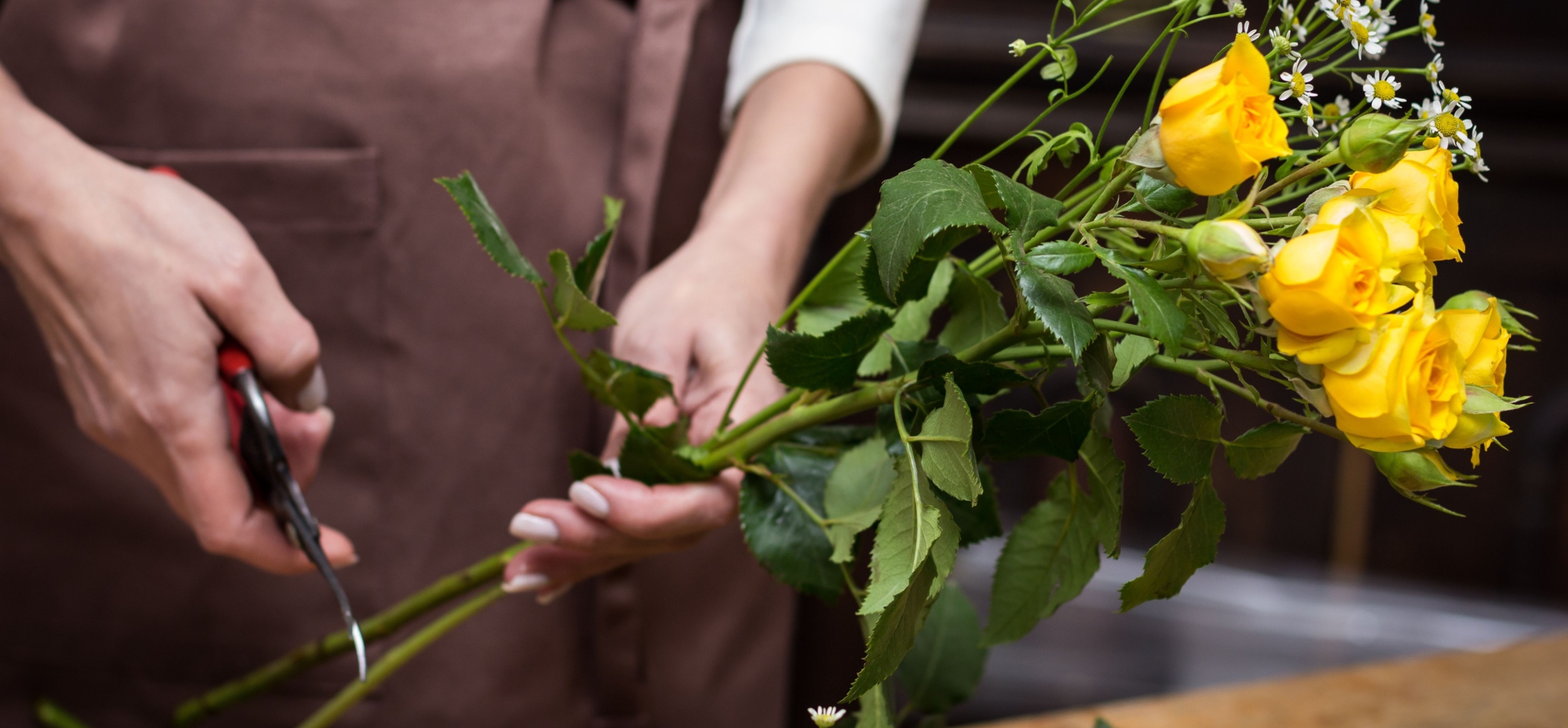No products in the cart.
Have you ever wondered what goes into creating those beautiful bouquets and arrangements you see in flower shops and at special events? Floristry, the art of arranging flowers and other plant materials, is a fascinating field that combines creativity, skill, and attention to detail. In this blog, we will explore the world of floristry, exploring its basics, techniques, and career paths.

What is Floristry?
Floristry is the art and profession of creating flower arrangements and other floral designs. It involves the selection, preparation, and arrangement of flowers, foliage, and other plant materials to create visually appealing and often fragrant displays. Moreover, florists use a variety of techniques, including cutting, trimming, and arranging, to create their designs. The art of floristry is not just about aesthetics; it also involves understanding the properties of different flowers and plants, their meanings, and how they can be used to convey messages and emotions.
History of Floristry
The history of floristry dates back thousands of years, with evidence of flower arrangements found in ancient civilisations such as Egypt, Greece, and Rome. In these cultures, flowers were used in religious ceremonies, as offerings to the gods, and as symbols of love and respect. The art of floristry continued to evolve through the centuries, with different cultures contributing their unique styles and techniques.
Techniques in Floristry
Floristry involves a variety of techniques that require skill and practice. Here are some of the key techniques used in floristry:
- Cutting and Trimming: This involves cutting the stems of flowers and foliage to the appropriate length for the arrangement. Florists use sharp knives or pruning shears to make clean cuts, which help the flowers absorb water better.
- Wiring: This technique is used to create more intricate designs. Florists use wire to attach flowers and foliage to each other or to a base.
- Taping: This method is used to secure stems together, especially in hand-tied bouquets.
- Foam: Floral foam is used to hold stems in place in vases and other containers.
- Arranging: This is the final step, where the florist places the flowers and foliage in a way that creates a visually appealing arrangement.
What Are The Types of Floristry?
There are several types of floristry, each with its own unique style and purpose:
- Event Floristry: This involves creating arrangements for special events such as weddings, parties, and corporate events.
- Retail Floristry: This is the most common type, where florists create arrangements for everyday sales in flower shops.
- Wholesale Floristry: This involves supplying flowers and arrangements to other businesses, such as hotels and restaurants.
- Freelance Floristry: Freelance florists work on a project-by-project basis, often creating custom arrangements for clients.

Career Paths in Floristry
Floristry offers a variety of career paths for those who are passionate about flowers and design. Some of the most common career paths are:
- Florist: A florist is responsible for creating flower arrangements and selling them in-store or online.
- Floral Designer: This role involves creating custom designs for special events and clients.
- Flower Shop Manager: This person oversees the daily operations of a flower shop, including managing staff, inventory, and customer service.
- Floral Educator: This role involves teaching floristry techniques and principles to students.
- Floral Consultant: This person advises businesses on how to use flowers and arrangements to enhance their brand and customer experience.
How to Become a Florist
Becoming a florist requires a combination of formal education and practical experience. Here are the steps to follow:
- Formal Education: Enrol in a floristry course or program. These programs are offered at vocational schools, community colleges, and some universities.
- Apprenticeship: Gain practical experience by working under an experienced florist.
- Certification: Consider obtaining a certification from a professional organization, such as the Institute of Professional Florists (IoPF) in the UK.
- Build Your Skills: Continuously improve your skills by attending workshops and seminars.
Tools and Materials Used in Floristry
Florists use a variety of tools and materials to create their designs. Here are some of the most common ones:
- Pruning Shears: Used for cutting stems.
- Floral Tape: Used to secure stems together.
- Floral Foam: Used to hold stems in place in vases.
- Vases and Containers: Used to display the arrangements.
- Wires and Pins: Used to create more intricate designs.
Tips for Creating Beautiful Arrangements
Creating beautiful flower arrangements requires attention to detail and a good understanding of colour, texture, and form. Here are some tips to help you get started:
- Choose a Theme: Decide on a theme or colour scheme to guide your selection of flowers and foliage.
- Select Fresh Flowers: Fresh flowers are essential for creating long-lasting arrangements.
- Use a Variety of Textures: Mixing different textures adds depth and interest to the arrangement.
- Balance the Arrangement: Ensure that the arrangement is balanced and visually appealing.
- Add Filler Flowers: Filler flowers like Baby’s Breath and Queen Anne’s Lace help to fill out the arrangement and create a fuller look.
Conclusion
Floristry is a beautiful and rewarding field that combines creativity, skill, and attention to detail. So, whether you are interested in pursuing a career in floristry or simply want to learn more about the art of flower arranging, understanding what is floristry is the first step. By exploring the history, techniques, and career paths in floristry, you can gain a deeper appreciation for this art form and perhaps even inspire you to create your own beautiful arrangements. To sum up, floristry is a multifaceted field that offers a variety of career paths and creative outlets. Whether you are a seasoned professional or just starting out, the art of floristry has something to offer everyone. So, the next time you see a beautiful bouquet or arrangement, remember the skill and craftsmanship that went into creating it.




